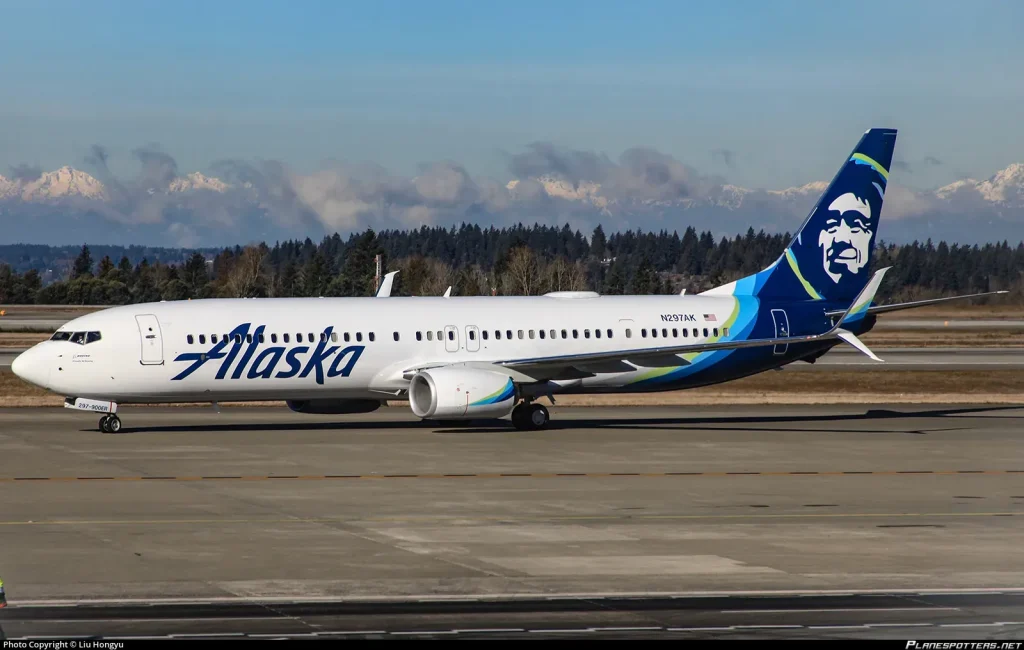Alaska Airlines is facing a challenging landscape as it navigates a reduction in travel demand, with its second-quarter profit outlook falling short of expectations. The airline has projected a six-percentage-point decline in revenue, reflecting broader trends within the airline industry, as many carriers report lower than anticipated bookings. Following its merger with Hawaiian Airlines last year, Alaska Airlines will not be updating its full-year forecast due to lingering economic uncertainty and volatility, although it remains hopeful for profitability in 2025. Despite its struggles, the airline experienced a 5% increase in unit revenue during the first quarter compared to the previous year, outperforming many larger competitors. As Alaska Airlines adapts to these shifts, its commitment to safety and customer care remains a cornerstone of its operational philosophy.
The recent developments surrounding Alaska Airlines highlight an array of factors influencing the airline’s financial projections. Amid a backdrop of decreased travel demand, which has resulted in a significant revenue decline, Alaska Airlines is adjusting its expectations for the short term. Having recently merged with Hawaiian Airlines, this carrier is grappling with various hurdles, including a dip in unit revenue for the second quarter. As other airlines also report similar challenges, the focus shifts to the evolving travel market dynamics and the resilience of these companies in adapting to changing consumer behavior. Alaska’s dedication to maintaining high standards of customer service remains evident even as they face economic headwinds.
Alaska Airlines Faces Revenue Challenges in 2025
As Alaska Airlines embarks on the second quarter of 2025, it is staring down a challenging revenue outlook. The airline has reported a projected six-percentage-point decline in revenue due to a notable drop in travel demand. This decline comes despite a previously optimistic first quarter in which Alaska’s unit revenue increased by 5% year-over-year. The airline’s adjustments reveal an unsettling trend that threatens its profitability, even though they maintain a commitment to remaining profitable amidst economic fluctuations.
The decision to merge with Hawaiian Airlines last year introduced new dynamics into Alaska’s operations. While this merger was expected to enhance travel capabilities and revenues, the current economic environment has created unexpected hurdles. Alaska Airlines has been consistent in highlighting economic uncertainty as a major factor affecting their outlook, leading to a cautious approach towards revising their full-year guidance. Such volatility forces Alaska Airlines to navigate carefully as they adapt to changing market conditions.
Impact of Market Trends on Alaska Airlines’ Profit Outlook
In the competitive airline industry, market dynamics are shifting, and Alaska Airlines is not immune to these trends. With numerous airlines reporting weaker-than-expected bookings, Alaska’s projections suggest that softer demand could drag down earnings further in 2025. Chief Financial Officer Shane Tackett emphasized, “the fares aren’t as strong as they were in the fourth quarter of last year,” highlighting the reality that current pricing pressures are limiting revenue potential.
This volatility also reflects broader economic conditions influencing traveler behavior. As consumers navigate economic uncertainty, many are opting for cheaper fares, which has impacted Alaska Airlines’ revenue goals. Meanwhile, industry analysts continue to monitor these developments, noting that despite the decline, demand for travel remains present. This paradox of high demand yet lower pricing indicates potential challenges for profitability that Alaska must strategize around moving forward.
Alaska Airlines and the Effects of Economic Volatility
The economic landscape of 2025 presents unique challenges for Alaska Airlines as it grapples with fluctuating travel demand. The airlines have long been susceptible to macroeconomic factors, such as rising fuel costs and changing consumer spending behaviors. Alaska’s leadership recognizes this volatility, as evidenced by their decision not to update their full-year profit forecast, citing the unpredictability that envelops the aviation sector amid signs of economic instability.
This hesitance to revise profit expectations stems from a comprehensive understanding of how quickly revenue can shift in the airline industry. Alaska Airlines, while conservative about future predictions, continues to focus on enhancing operational efficiency and customer care, critical elements during tougher market periods. The company’s commitment to safety and performance will be vital as they work to reassure travelers and stabilize revenue in a time of uncertainty.
Hawaiian Airlines Merger and Its Implications for Alaska Airlines
The strategic merger between Alaska Airlines and Hawaiian Airlines has been one of the pivotal shifts for the carrier in recent times. This merger was generally seen as a pathway towards increased market share and an expansion into new routes, solidifying Alaska’s foothold in the Pacific region. However, the recent decline in travel demand has raised questions regarding the immediate benefits of this merger, as Alaska has to balance the integration of its services with a market that is currently unpredictable.
While the merger aimed to create synergies and enhance customer offerings, Alaska must now navigate the complexities that come with such an integration under adverse market conditions. The interplay between the two airlines could result in re-evaluating service models and fare structures aimed at attracting a broader customer base. Understanding how to leverage the Hawaiian brand alongside Alaska’s established presence will be essential to navigate post-merger profitability.
Travel Demand Trends Affecting Alaska Airlines
The ongoing fluctuations in travel demand have become a critical factor for Alaska Airlines as they prepare for the latter half of 2025. With the company expecting reduced demand evidenced by lower bookings, there is a stark contrast to the previous year when demand trends were more favorable. Alaska’s statements reveal that customers are still eager to book flights, but the average fare is significantly less than what was previously projected.
Understanding these trends requires recognizing the broader context of consumer behavior changes. As more travelers seek cost-effective options, Alaska Airlines may need to adapt its marketing strategies and pricing structures to remain competitive. Keeping a close eye on consumer sentiment and travel preferences will be vital for influencing future revenue and shaping the airline’s operational decisions in the coming quarters.
Financial Performance Analysis of Alaska Airlines in Q1
In analyzing their financial performance, Alaska Airlines’ first quarter results revealed a mixed bag of outcomes. With a net loss of $166 million reported for the quarter, which represented an increase compared to the previous year’s loss, it became evident that the airline is operating under considerable pressure. Revenues of $3.14 billion, while reflecting a significant year-over-year increase of 41%, still fell short of analyst expectations, indicating an underlying struggle to meet performance goals.
The projected losses during this quarter illuminate the need for strategic recalibration within the company. As airlines face ongoing challenges from economic shifts and competition, Alaska Airlines must work diligently to uncover new pathways to profitability. This includes scrutinizing operational efficiencies, diversifying their offerings, and fostering customer loyalty to stabilize their financial performance as external pressures mount.
The Future of Alaska Airlines Amidst Economic Uncertainties
As we look towards the future of Alaska Airlines, the company faces a landscape riddled with uncertainties and competitive pressures. Although management has voiced optimism about staying profitable in 2025, the potential for additional revenue decline remains a serious concern. Economic indicators such as consumer spending patterns and fuel prices will play a pivotal role in shaping Alaska’s ability to navigate the turbulence ahead.
To strengthen its future positioning, Alaska Airlines needs to embrace a proactive approach in addressing the barriers to profitability they face in the near term. This requires not only an agile operational strategy but also the cultivation of deeper connections with their customer base to encourage travel in difficult economic conditions. By fostering a resilient brand, Alaska Airlines can better weather the storm and emerge as a robust competitor in the ever-evolving airline industry.
Strategic Steps for Alaska Airlines’ Recovery
In light of current developments, Alaska Airlines is focusing on strategic steps aimed at recovery and stabilization. These include optimizing flight routes, enhancing customer service, and revisiting fare structures to attract a wider traveler demographic. By identifying inefficiencies in operations and capitalizing on emerging travel trends, Alaska can position itself to better meet the challenges posed by softer demand in the airline sector.
Furthermore, continuing to improve the customer travel experience can lead to enhanced loyalty and repeat bookings, which are essential for long-term growth. As Alaska Airlines moves forward, leveraging insights gained from industry performance and customer preferences will be crucial in not only overcoming immediate challenges but also in setting a solid foundation for future success.
Navigating the Competitive Landscape of Airlines in 2025
The airline industry in 2025 is characterized by fierce competition and the need for adaptability. For Alaska Airlines, standing out among larger carriers while managing declining revenue becomes a complex task. As travel demand remains volatile, Alaska must continue to innovate in service offerings and customer engagement strategies to maintain its market position.
Additionally, Alaska Airlines should monitor competitors closely, assessing their pricing strategies and service enhancements. By understanding where competitors may leverage strengths or exploit weaknesses, Alaska can effectively strategize its market position to not only counteract revenue declines but to also establish a competitive edge in an ever-evolving travel landscape.
Frequently Asked Questions
What is the current profit outlook for Alaska Airlines in 2025?
Alaska Airlines has indicated that its profit outlook for 2025 is still positive despite a projected revenue decline for the second quarter. The company anticipates adjusted earnings per share to be between $1.15 and $1.65, although this is lower than previous analyst expectations of $2.47 per share.
How is the revenue decline affecting Alaska Airlines’ operations?
Alaska Airlines has forecasted a six-percentage-point decline in revenue for the second quarter due to reduced travel demand. While bookings have stabilized, the airline is facing challenges with softer demand, impacting its expected earnings.
What factors contributed to the decline in travel demand for Alaska Airlines?
Reduced travel demand for Alaska Airlines can be attributed to economic uncertainty and volatility, which have influenced customer booking behaviors, leading to lower prices compared to earlier expectations.
How did Alaska Airlines perform in the first quarter of 2025?
In the first quarter of 2025, Alaska Airlines reported a net loss of $166 million, though revenue reached over $3.14 billion, a significant increase from the previous year. However, this revenue fell short of analysts’ forecasts.
What impact did the merger with Hawaiian Airlines have on Alaska Airlines?
The merger with Hawaiian Airlines last year has shaped Alaska Airlines’ strategy. Despite the current economic challenges, the company remains focused on maintaining profitability and enhancing its operational performance in a competitive market.
What are the expectations for Alaska Airlines’ unit revenue in the second quarter?
Alaska Airlines expects its unit revenue to be flat or potentially decrease by up to 6% in the second quarter of 2025, reflecting the impact of softer travel demand on earnings.
How does Alaska Airlines plan to navigate economic uncertainty in 2025?
Alaska Airlines plans to navigate the economic uncertainty in 2025 by focusing on safety, customer care, and operational performance. The airline remains committed to controlling costs while striving to maintain profitability amidst revenue pressures.
What are analysts forecasting for Alaska Airlines’ future revenue trends?
Analysts are cautious about future revenue trends for Alaska Airlines due to the reported decline in travel demand and the airline’s recent challenges. However, the airline still expects to remain profitable despite these pressures.
| Key Points | |
|---|---|
| Declining Demand for Q2 | Alaska Airlines expects a six-percentage-point decline in revenue. |
| Economic Uncertainty | The airline will not update its full-year forecast due to economic uncertainty. |
| Profitability Expectations | Despite the challenges, Alaska Airlines still anticipates remaining profitable in 2025. |
| Unit Revenue Expectations | Second-quarter unit revenue expected to be flat or down by 6% year-on-year. |
| Earnings per Share | Adjusted earnings per share projected to be between $1.15 to $1.65, lower than expectations. |
| Bookings Trends | Bookings have stabilized but are lower than anticipated. |
| CEO’s Statement | CEO Ben Minicucci expressed confidence in the airline’s performance despite economic challenges. |
Summary
Alaska Airlines is grappling with declining demand, as highlighted by their forecast of a six-percentage-point revenue drop in the second quarter. The economic uncertainty casts a shadow on their financial outlook, yet the airline remains committed to profitability in 2025. With a focus on safety and customer care, Alaska Airlines aims to navigate these turbulent times while meeting the evolving expectations of travelers.



